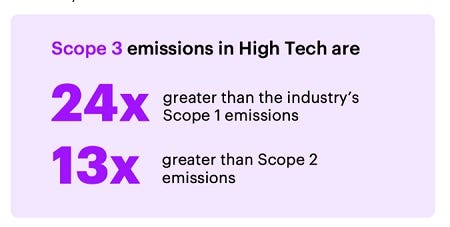The Urgency to Reduce Scope 3 Emissions in High TechThe Urgency to Reduce Scope 3 Emissions in High Tech
Reducing Scope 3 emissions for high-tech companies has been difficult due to a lack of visibility across the supply chain. Here are some steps to get started.

Sustainability has been a key theme for high-tech companies over the past few years, and although many have made commitments to reduce Scope 1 and 2 emissions, not many have been focused on reducing Scope 3 emissions. This is surprising considering that Scope 3 emissions -- which come from their upstream supplier base -- comprise a massive portion of the industry’s overall emissions. In fact, in the high-tech industry, Scope 3 emissions are 24x greater than Scope 1 emissions and 13x greater than Scope 2 emissions.

Source: Accenture
Eighty-six percent of high-tech Scope 3 emissions is coming from tier 2 and tier 3 suppliers. Of this percentage, 62% is coming from tier 3 alone. This creates a challenge because emissions that far down are difficult to identify, and thereby more difficult to eliminate.
Overcoming Scope 3 Emission Challenges
One of the biggest challenges for high-tech companies is an overall lack of visibility across the supply chain. That is likely why only 32% of high-tech companies globally have taken the first step to include Scope 3 within their net-zero targets.
To overcome this, these companies should start mapping suppliers at the different tiers, and then agree on the definitions used to calculate emissions. This will allow them to effectively work with suppliers who contribute the most CO2 emissions and give them a target to reach to reduce their overall emissions. The initial focus should be on Tier 1 suppliers, and then play an orchestration role across remaining tiers, supporting Tier 1 suppliers in building momentum and drive progress across Tier 2, 3 and beyond.
The Five First Steps
Unless high-tech companies act today, it is very likely the industry will miss its net-zero goals. Below are the top five things to begin the journey:
companies can determine the biggest sources of emissions. This insight will provide them with a foundation to build a roadmap and action plan to address the areas where companies can unlock the greatest value.
companies should work with their suppliers to establish clear metrics, reporting, and accountabilities for achieving Scope 3 targets. With Scope 3 representing the biggest opportunity for reducing emissions, they can collaborate to meet these set targets.
High-tech companies have already been onshoring product manufacturing to enhance their resilience and transparency and increase diversification. With sustainability in mind, this is an opportunity to rethink where to move, or where to build new assets and facilities. For example, opting for suppliers where renewable energy is more readily available can help reduce carbon footprint because it’s likely to have access to better technology and more renewable energy.
Looking across the value chain, there are opportunities to meet sustainability goals by investigating ‘recycling’ opportunities such as a take-back program to promote (and pay consumers for) recycling of consumer electronic devices. This promotes greater circularity and enables customers to fix the devices they own to extend their productive lives.
Leveraging R&D can help boost sustainability with both existing and new products. For example, by offering as-a-service options and device subscriptions, companies can reduce energy consumption and maintain control over the hardware throughout its life cycle. Similarly, R&D can help design new products, services and packaging that are built from the ground-up to be sustainable. One way they could do this is by either increasing the number of recyclable materials they are already using or adding recycle materials where they never have before. Another option is to partner with renewable electricity providers that will enable suppliers to consume 100% renewable electricity in their production lined.
All Roads Lead to Sustainability
There are many benefits to reducing Scope 3 emissions, which is why it should be a key focus for high-tech companies. Not only can these initiatives help to tackle climate change on a global basis, but they can also help improve energy efficiency and reduce overall operating costs as companies switch to renewable electricity. These sustainability efforts can also help their brand because consumers are increasingly concerned about climate change and given the option, they are going to purchase from a company that they believe is helping to protect their world. At the end of the day, consumers are happy, employers like working for a company that cares about their environment, suppliers have a partner they can work with to improve their own sustainability, and investors measuring how these initiatives can significantly help a company’s bottom line.
In the future, all roads will lead to sustainability and what better way to move the needle than by going after a piece of the pie (Scope 3) that is significantly greater than other pieces (Scope 1 and Scope 2.)
About the Author
You May Also Like






